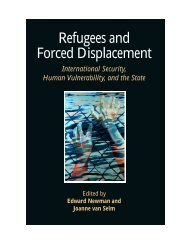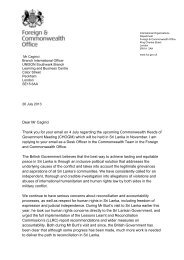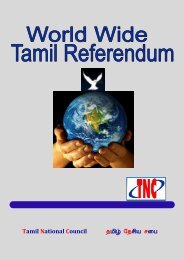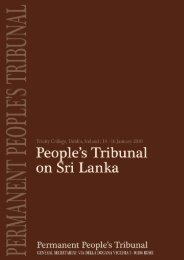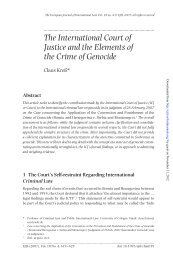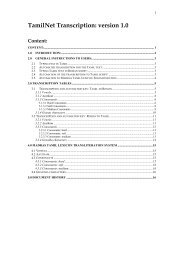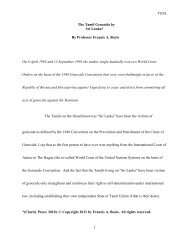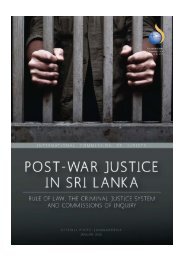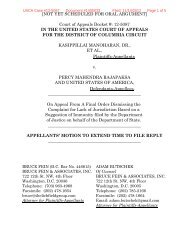Proposal to encode characters for Extended Tamil §1 ... - TamilNet
Proposal to encode characters for Extended Tamil §1 ... - TamilNet
Proposal to encode characters for Extended Tamil §1 ... - TamilNet
You also want an ePaper? Increase the reach of your titles
YUMPU automatically turns print PDFs into web optimized ePapers that Google loves.
4a. The context of use <strong>for</strong> the proposed <strong>characters</strong> (type of use; common or rare)Common in the context of Sanskrit religious books printed in <strong>Tamil</strong> Nadu.4b. Reference5a. Are the proposed <strong>characters</strong> in current use by the user community?Yes, often.5b. If YES, where?In publications in <strong>Tamil</strong> Nadu of Sanskrit religious texts.6a. After giving due considerations <strong>to</strong> the principles in the P&P document must the proposed <strong>characters</strong> beentirely in the BMP?No.6b. If YES, is a rationale provided?6c. If YES, reference7. Should the proposed <strong>characters</strong> be kept <strong>to</strong>gether in a contiguous range (rather than being scattered)?Yes, since it is only logical <strong>to</strong> keep mutually related <strong>characters</strong> <strong>to</strong>gether.8a. Can any of the proposed <strong>characters</strong> be considered a presentation <strong>for</strong>m of an existing character orcharacter sequence?No.8b. If YES, is a rationale <strong>for</strong> its inclusion provided?8c. If YES, reference9a. Can any of the proposed <strong>characters</strong> be <strong>encode</strong>d using a composed character sequence of either existing<strong>characters</strong> or other proposed <strong>characters</strong>?No.9b. If YES, is a rationale <strong>for</strong> its inclusion provided?9c. If YES, reference10a. Can any of the proposed character(s) be considered <strong>to</strong> be similar (in appearance or function) <strong>to</strong> anexisting character?In some glyphic variants, the <strong>characters</strong> resemble Grantha <strong>characters</strong> and in others they resemble<strong>Tamil</strong> <strong>characters</strong> in combination with superscript digits10b. If YES, is a rationale <strong>for</strong> its inclusion provided?Yes.10c. If YES, referenceThe rationale is that these <strong>characters</strong> are used as part of the (<strong>Extended</strong>) <strong>Tamil</strong> script and are differentfrom those glyphically similar <strong>characters</strong> in function and behaviour. The existence of many glyphicvariants (as in the case of Old Italic and Brahmi) is also a justification <strong>for</strong> separate encoding.11a. Does the proposal include use of combining <strong>characters</strong> and/or use of composite sequences (see clauses4.12 and 4.14 in ISO/IEC 10646-1: 2000)?No.11b. If YES, is a rationale <strong>for</strong> such use provided?11c. If YES, reference11d. Is a list of composite sequences and their corresponding glyph images (graphic symbols) provided?No.12a. Does the proposal contain <strong>characters</strong> with any special properties such as control function or similarsemantics?No.12b. If YES, describe in detail (include attachment if necessary)13a. Does the proposal contain any Ideographic compatibility character(s)?No.<strong>§1</strong>1. Code chartAs mentioned in §5, due <strong>to</strong> the wide glyphic variation of these <strong>characters</strong> (such as in OldItalic and Brahmi) a particular set of representative glyphs should be chosen <strong>for</strong> <strong>Extended</strong><strong>Tamil</strong>. I suggest that the glyphs corresponding <strong>to</strong> (a variant of) ET-C be chosen, because thecurrent TUS description of the <strong>Tamil</strong> script refers <strong>to</strong> ET-C only.14




